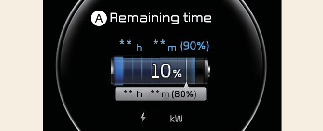DC charge

You can charge at high speeds at public charging stations. Refer to the respective company's manual for each DC charger type.
Battery performance and durability can deteriorate if the DC charger is used constantly.
The use of DC charge should be minimised to help prolong high voltage battery life.
The actual charger image and charging method may vary in accordance with the charger manufacturer.
How to connect DC charger
-
Depress the brake pedal and apply the parking brake.
-
Turn OFF all switches, shift to P (Park), and turn OFF the vehicle.
-
Open the charging door.
For more details, refer to More Details.
-
Check whether dust or foreign substances are inside the charging connector and charging inlet.
-
Hold the charging connector handle and connect it to the vehicle charging inlet. Push the connector all the way in. If the charging connector and charging terminal are not connected properly, this may cause a fire. Refer to the manual for each type of DC charger for how to charge and remove the charger.
-
Check if the charging indicator light (
 ) of the high voltage battery in the instrument cluster is turned ON. Charging is not active when the charging indicator light
(
) of the high voltage battery in the instrument cluster is turned ON. Charging is not active when the charging indicator light
( ) is OFF.
) is OFF.
When the charging connector is not connected properly, reconnect the charging cable to charge it again.
During cold weather, DC charging may not be available to prevent high voltage battery degradation.

-
After charging has started, the estimated charging time is displayed on the instrument cluster for about 1 minute. If you open the driver seat door whilst charging, the estimated charging time is also displayed on the instrument cluster for about 1 minute.

A: Remaining Time
Checking charging status
When charging
the high voltage battery, the charge level can be checked from outside the vehicle.
For more details, refer to More Details.
How to disconnect DC charger
-
Remove the charging connector using the DC charger when DC charging is complete or after you stop charging. Refer to each DC charger manual for details about how to disconnect the charging connector.
-
Make sure to completely close the charging door.

-
If you use a DC charger when the vehicle is already fully charged, some DC chargers will send out an error message. When the vehicle is fully charged, do not charge the vehicle.
-
If you cannot open the charging door due to freezing weather, tap lightly or remove any ice near the charging door. Do not try to forcibly open the charging door.
-
To control the temperature of the high-voltage battery whilst charging, the air conditioner is used to cool down the battery, which may generate noise from the operation of the air conditioner compressor and cooling fan.
Also, the air conditioner's performance may be degraded during summer due to the operation of the cooling system for the high voltage battery.
-
Even though charging is possible with the EV button in the ON/START position, for your safety, start charging when the EV button is in the OFF position, and the vehicle in P (Park). After charging has started, you can use electrical components such as the radio by pressing the EV button to the ACC or ON position.
During charging, the gear cannot be shifted from P (Park) to any other gear.
-
Depending on the condition and durability of the high voltage battery, charger specifications, and ambient temperature, the time required for charging the battery may vary.
-
If the charging connector and charging inlet are not connected properly, the connector may droop or vibrate. In this case, hold the charging connector handle and push it all the way in.
-
Pressing the release button on the charging connector may result in interrupted charging and connector separation even when it is locked.